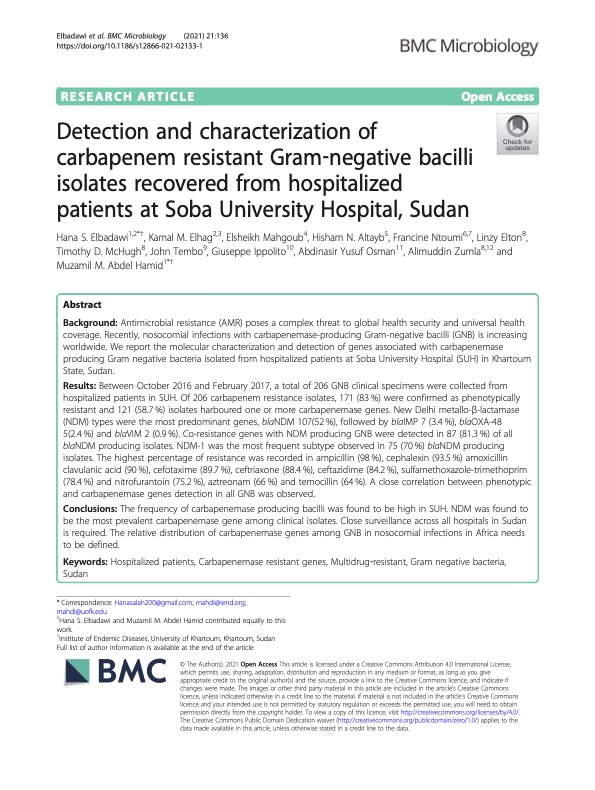HS Elbadawi
Detection and characterization of carbapenem resistant Gram-negative bacilli isolates recovered from hospitalized patients at Soba University Hospital, Sudan
Elbadawi, HS; Elhag, KM; Mahgoub, E; Altayb, HN; Ntoumi, F; Elton, L; McHugh, TD; Tembo, J; Ippolito, G; Osman, AY; Zumla, A; Hamid, MMA
Authors
KM Elhag
E Mahgoub
HN Altayb
F Ntoumi
L Elton
TD McHugh
J Tembo
G Ippolito
AY Osman
A Zumla
MMA Hamid
Abstract
Background: Antimicrobial resistance (AMR) poses a complex threat to global health security and universal health coverage. Recently, nosocomial infections with carbapenemase-producing Gram-negative bacilli (GNB) is increasing worldwide. We report the molecular characterization and detection of genes associated with carbapenemase producing Gram negative bacteria isolated from hospitalized patients at Soba University Hospital (SUH) in Khartoum State, Sudan. Results: Between October 2016 and February 2017, a total of 206 GNB clinical specimens were collected from hospitalized patients in SUH. Of 206 carbapenem resistance isolates, 171 (83 %) were confirmed as phenotypically resistant and 121 (58.7 %) isolates harboured one or more carbapenemase genes. New Delhi metallo-beta-lactamase (NDM) types were the most predominant genes, blaNDM 107(52 %), followed by blaIMP 7 (3.4 %), blaOXA-48 5(2.4 %) and blaVIM 2 (0.9 %). Co-resistance genes with NDM producing GNB were detected in 87 (81.3 %) of all blaNDM producing isolates. NDM-1 was the most frequent subtype observed in 75 (70 %) blaNDM producing isolates. The highest percentage of resistance was recorded in ampicillin (98 %), cephalexin (93.5 %) amoxicillin clavulanic acid (90 %), cefotaxime (89.7 %), ceftriaxone (88.4 %), ceftazidime (84.2 %), sulfamethoxazole-trimethoprim (78.4 %) and nitrofurantoin (75.2 %), aztreonam (66 %) and temocillin (64 %). A close correlation between phenotypic and carbapenemase genes detection in all GNB was observed. Conclusions: The frequency of carbapenemase producing bacilli was found to be high in SUH. NDM was found to be the most prevalent carbapenemase gene among clinical isolates. Close surveillance across all hospitals in Sudan is required. The relative distribution of carbapenemase genes among GNB in nosocomial infections in Africa needs to be defined.
Citation
Elbadawi, H., Elhag, K., Mahgoub, E., Altayb, H., Ntoumi, F., Elton, L., McHugh, T., Tembo, J., Ippolito, G., Osman, A., Zumla, A., & Hamid, M. (2021). Detection and characterization of carbapenem resistant Gram-negative bacilli isolates recovered from hospitalized patients at Soba University Hospital, Sudan. BMC Microbiology, 21(1), https://doi.org/10.1186/s12866-021-02133-1
| Journal Article Type | Article |
|---|---|
| Acceptance Date | Feb 23, 2021 |
| Publication Date | 2021 |
| Deposit Date | Jan 7, 2022 |
| Publicly Available Date | Jan 7, 2022 |
| Journal | BMC Microbiology |
| Electronic ISSN | 1471-2180 |
| Publisher | BioMed Central |
| Peer Reviewed | Peer Reviewed |
| Volume | 21 |
| Issue | 1 |
| DOI | https://doi.org/10.1186/s12866-021-02133-1 |
| Keywords | Hospitalized patients; Carbapenemase resistant genes; Multidrug-resistant; Gram negative bacteria; Sudan; KLEBSIELLA-PNEUMONIAE; ACINETOBACTER-BAUMANNII; MOLECULAR CHARACTERIZATION; ESCHERICHIA-COLI; BETA-LACTAMASE; ENTEROBACTERIACEAE; EPIDEMIOLOGY; EMERGENCE; INFECTION; BACTERIA |
| Public URL | https://rvc-repository.worktribe.com/output/1554830 |
Files
OA
(148 Kb)
Image
Publisher Licence URL
http://creativecommons.org/licenses/by/4.0/
You might also like
Designing a Multi-Epitope Vaccine against Toxoplasma gondii: An Immunoinformatics Approach
(2022)
Journal Article
High Prevalence and New Genotype of Coxiella burnetii in Ticks Infesting Camels in Somalia
(2021)
Journal Article
Verbal autopsy to assess child mortality in a humanitarian setting
(2021)
Journal Article
Downloadable Citations
About RVC Repository
Administrator e-mail: publicationsrepos@rvc.ac.uk
This application uses the following open-source libraries:
SheetJS Community Edition
Apache License Version 2.0 (http://www.apache.org/licenses/)
PDF.js
Apache License Version 2.0 (http://www.apache.org/licenses/)
Font Awesome
SIL OFL 1.1 (http://scripts.sil.org/OFL)
MIT License (http://opensource.org/licenses/mit-license.html)
CC BY 3.0 ( http://creativecommons.org/licenses/by/3.0/)
Powered by Worktribe © 2025
Advanced Search

